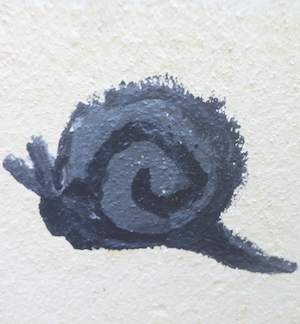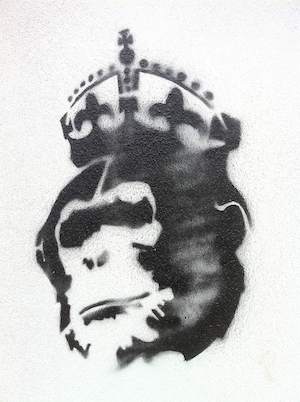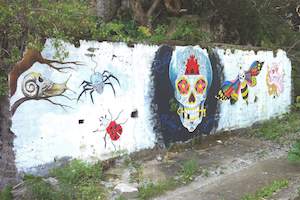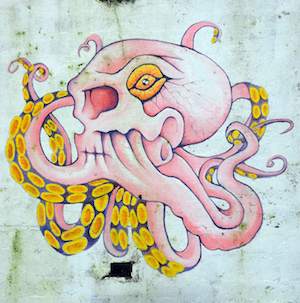|
What do we think about graffiti, and why publish an article about graffiti in Mollusc World? Many argue that graffiti has been a part of human culture since the drawing of the first pictures in caves. Although we mostly use the term graffiti when talking about one or more items, 'graffito', although rarely used, is the singular of 'graffiti'. The word derives from the Greek 'Graphein' which means 'to write'. This in itself gives a clue as to what most authors on the subject agree on, namely that graffiti is the act of drawing or writing on walls or other surfaces in order to communicate messages to the public. There is an enormous literature on whether graffiti is art or crime. As a layman, I suspect that the way most people might decide whether graffiti is art or crime centres mainly on location. If a graffito is somewhere 'acceptable', perhaps the side of a building where it may be obvious it has been commissioned, it is art; if, on the other hand someone has created a piece on a wall in an underground railway station or on the side of a shop, it is 'defacing' and thus seen as a crime. In addition, graffiti that are pleasing to the eye are much more likely to appeal to the viewer than items that consist of letters or words only, wherever they are located.
Over the years I have built up a collection of photos of graffiti I have seen around Gibraltar, more particularly graffiti that have a natural history flavour. I started my collection when I discovered a small graffito on a wall in my garden of a snail that my young son, Alex, had painted clandestinely (figure 1).
I have many pictures, including those of the ‘Gibraltar Monkey Queen’ that mysteriously appeared around Gibraltar starting in May of 2011 (figure 2) resembling Banksy’s famous ‘Monkey Queen’. We might expect molluscs not to be high up on the graffiti artist’s list of subjects, but there is a location in Gibraltar where we see two mollusc classes represented by graffiti. Some of my favourite graffiti are on a wall outside the north entrance of the Prince's Gallery tunnel at the Northern Defences (colloquially called 'The Jungle'). While it may be difficult to put oneself into the mind of the artist(s) responsible, the mix of species used and incorporation of skulls into the designs, along with the bright colours, provide an unusual (and possibly psychedelic) effect (figure 3). Looking closely we can see both a snail and octopus in the design, both incorporating the skull theme (figures 4 and 5).
I wonder how many readers have seen other molluscan graffiti and if they have photos of these? |
figure 1: Graffito of a snail, by my son. figure 2: First graffito (Market Square) of The ‘Gibraltar Monkey Queen' (Photo: Alex Menez)
figure 3: ‘Graffiti Wall’ at the Northern Defences (‘The Jungle’). Note the use of a human skull theme. (Photo: Alex Menez)
figure 4: Detail from ‘Graffiti Wall’: a snail. (Photo: Alex Menez)
figure 5: Detail from ‘Graffiti Wall’: an Octopus. (Photo: Alex Menez) |
Molluscan Graffiti
Issue
28
Page
11





